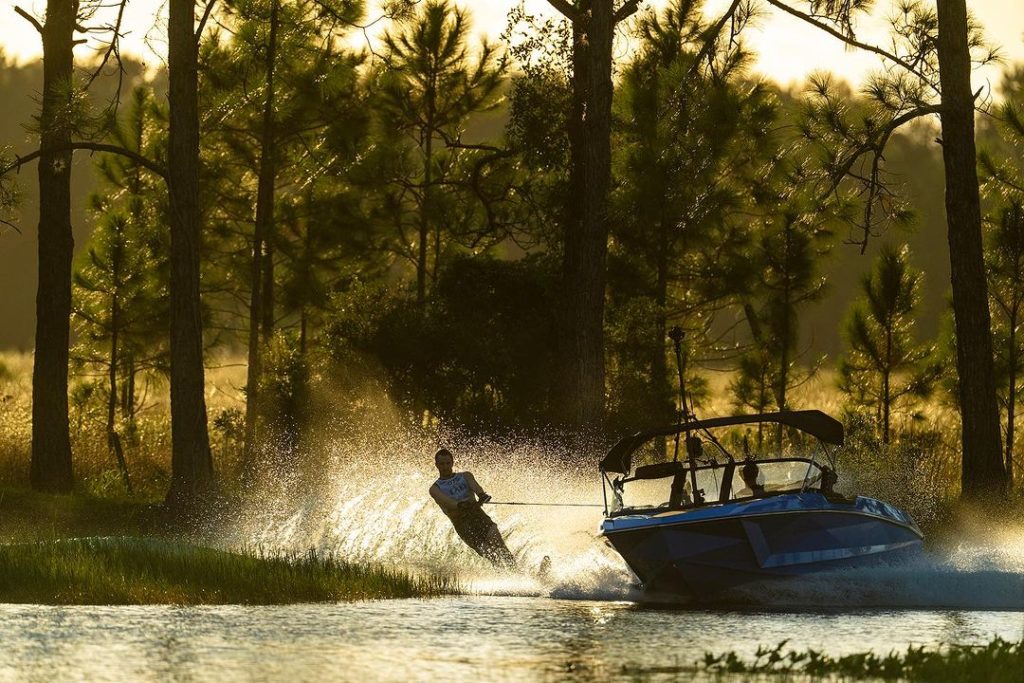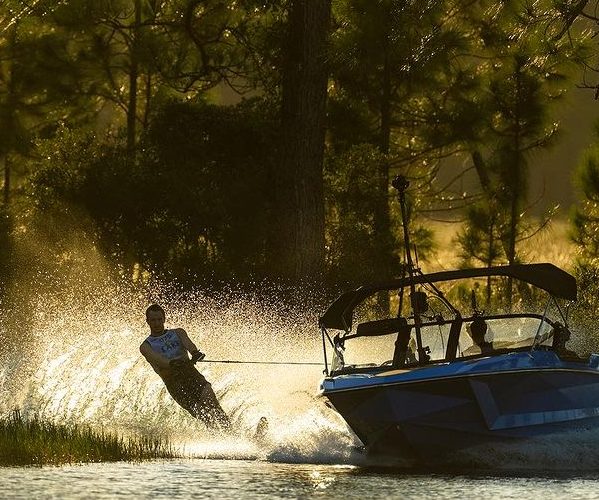Thrills, spills, and triumphs: highlights from the 2023 World Championships

Cole McCormick slaloms at sunset during the 2023 IWWF World Championships (image: @johnnyhayward_photo)
By Jack Burden
The 2023 IWWF World Water Ski Championships proved to be a thrilling showcase of skill and determination, with each day bringing its own set of remarkable moments and challenges. From the impressive kickoff early in the week, to the unexpected turns in the tournament caused by adverse weather conditions, this competition was a rollercoaster of excitement and resilience. The water skiing world watched in anticipation as emerging talents and seasoned champions went head-to-head, vying for world titles and displaying the sheer tenacity that defines this sport. Here, we delve into the highlights and surprises from this extraordinary event, setting the stage for the action-packed journey that followed.
Young Talent Shines Early
Day one featured a full day of slalom skiing under perfect conditions, with over 70 skiers in total. While some might consider these early rounds as a curtain raiser, they still delivered some incredible performances. Notably, 17-year-old Italian skier Vincenzo Marion took the lead by running 2 at 10.25 meters (41′ off). Setting the pace early with 38 of the world’s top-ranked skiers yet to compete.
Moving on to Wednesday, it was time for the lower-seeded competitors in the jump and trick events to showcase their skills. This day was marked by numerous emerging talents achieving personal bests in the jump competition. Jutta Menestrina, making a remarkable comeback from knee surgery, posted an impressive score in the third series of the women’s jump. On the men’s side, Marino once again delivered an outstanding performance, achieving a personal best jump by 5.6 meters, crossing the 60-meter mark for the first time in his career.
Battling the Elements
Thursday marked the onset of dramatic developments as heavy rain showers and strong winds intensified throughout the morning. These adverse conditions prompted officials to suspend the women’s slalom competition midway through the third series. Following consultations with officials and team captains, the decision was made to postpone the women’s slalom to the following day. The weather conditions proved extremely challenging, with intermittent heavy rain and white caps on the lake, making it extremely difficult for both skiers and even the boat drivers to navigate the course for much of the day.
This postponement, although necessary for safety, came at a cost due to the tight schedule for the weekend. Despite the forecast predicting better conditions on Friday, the early seeds of women’s slalom and the top seeds of men’s slalom would have to contend with sun glare and reflection in the morning and afternoon, as the lake runs from east to west.
In the midst of these weather challenges, the men’s tricks elimination round proceeded as scheduled on Thursday afternoon. Skiers faced the daunting task of battling strong winds and bumpy conditions in the first completed elimination round of the tournament. The quality of tricks, which has been steadily rising in recent years, remained exceptional despite the unfavorable conditions. The French team exhibited remarkable prowess, with both veteran Pierre Ballon and newcomer Pol Duplan-Fribourg leading the pack out of series two.
As the saying goes, the overall event is won or lost in the trick event, and this held true at this World Championships. Notably, Italian skier Edoardo Marenzi, who was nursing an Achilles injury, exited early, effectively ending his campaign. Defending trick champion Dorien Llewellyn, competing in his first trick tournament in six months, and former overall champion Martin Kolman did enough to secure their spots in the finals. However, the biggest upset of the tournament occurred when the clear favorite, Joel Poland, who only needed 10,000 points to make the final, fell during his signature Super-Mobe-Five, ruling himself out of the final and overall contention—or so it seemed.
In a defining moment, as Poland experienced this unexpected setback, the next skier off the dock, Frenchman Louis Duplan-Fribourg, emerged as the new favorite in the overall event. Instead of succumbing to the mounting pressure, he took a daring approach, opting for the hardest run in his repertoire. In doing so, he set a new personal best with 12,510 points, earning himself the French national trick record and a World Championships record. The skier who previously held the latter record, Patricio Font, responded in thrilling fashion by reclaiming his World Championships record only three skiers later, matching his own world record and securing the top seed position.
Nonstop Action Shines Through (A Little Too Bright)
Friday delivered another action-packed day of slalom skiing, with the top three series of both women’s and men’s slalom running. On a separate lake, the women’s trick preliminaries took place concurrently throughout the afternoon. Among the top female slalomers, there were no major upsets, but unexpected subpar performances from prominent overall contenders Giannina Bonnemann Mechler and Paige Rini set them back considerably. The cut for the finals remained comparable to 2021, with a runoff at 1.5 @ 10.75m (39.5’ off).
The afternoon treated viewers to one of the most thrilling and engaging broadcasts ever produced by TWBC. It featured simultaneous men’s slalom and women’s trick skiing, earning comparisons to “NFL’s RedZone.” The excitement peaked during the start of the women’s series one tricks. On one lake, the women’s overall title was being determined, with the likes of Hanna Straltsova, Kennedy Hansen, and Paige Rini competing. On the other lake, the down-and-out Joel Poland, who had shaved his head overnight, skied with the determination of a man with nothing to lose. Poland took a bold approach, attacking the 10.25m (41’ off) pass rather than taking the safer route of securing his spot in the final with an S-turn mid pass. The Brit produced the defining performance of the World Championships, becoming the newest member of the 41-off club. Suddenly, he was back in the overall title race.
Women’s trick skiing concluded in spectacular fashion, with three athletes surpassing 10,000 points. Erika Lang claimed the pole position with a World Championships record of 10,930 points. As all eyes shifted to the slalom lake for the final series, the sun dipped lower on the horizon. Competitors had to adapt to the challenging glare. Joel Howley became the first skier to wear sunglasses during his run, with the boat driver handing them to him for each pass into the glare. Others attempted to mitigate the increasingly difficult glare with eye black. In a candid interview, Freddie Winter commented on the conditions, emphasizing that “we’re all trying to survive as opposed to perform.” Further stating “it’s dangerous, it’s scary, and it minimizes our performance.”
While the conditions were far from ideal and arguably hazardous for the top series of men’s slalom, in an event with limited time and significant weather-related disruptions, the officials made the right call. The alternatives, such as running the women’s slalom in the rainy and whitecap-filled conditions from the previous day or scheduling the jump preliminaries in similar glare or strong gusty tailwinds the following day, would have been significantly more dangerous.
Despite the challenging conditions, most of the top skiers successfully advanced to the finals. Notably, two-time former champion Will Asher suffered an early exit at 10.25m. The day concluded with an electrifying eight-way runoff for the final two spots, with young Marino attempting a 10.75m pass in what might be the coldest start ever after not skiing for three days. In the end, Cole McCormick and Corey Vaughan secured their tickets to the finals.
The First World Champions Are Crowned
The penultimate day of the competition brought an abundance of excitement with five series of jump preliminaries. As anticipated, the cut in women’s jump was lower than two years ago, mainly due to an injury-plagued field. Straltsova had an unusual off day, still managing to secure the top seed position but failing to cement her overall title chances. She finished the prelims just behind Bonnemann Mechler after an underwhelming, by her standards, 54.1-meter (177-foot) performance.
The men’s jump competition provided non-stop excitement, with an impressive 21 men surpassing the 200-foot barrier. Overall hopefuls Louis Duplan-Fribourg and Llewellyn narrowly missed the finals, leaving room for a potential comeback from Poland, who secured the second-to-top seed. The veteran Freddy Krueger put Team USA and the fans through some nerve-wracking moments, as he didn’t secure his finals spot until his third jump. It was the defending champion, Ryan Dodd, who claimed the top seed position.
Attention then shifted to the trick lake as the first world champions of the tournament were to be crowned. The early seeds, including many young skiers competing in their first-ever finals, encountered a series of stumbles and early falls while attempting to achieve high scores. Straltsova made significant improvements over the preliminary round, effectively securing the overall title. Three-time world champion Anna Gay led the event early, despite a fall on her final flip, and had to watch from the shore as Peruvian Natalia Cuglievan came up just 10 points short of her lead. Then, Bonnemann Mechler and Neilly Ross went down early while chasing big scores. It all came down to Erika Lang in the end, who, despite being one of the most dominant trickers in the sport over the last decade, had not secured World Championships gold since 2013. Although she appeared shaky at times, she managed to complete both passes and earn a well-deserved second world title.
In stark contrast to the low-scoring final in 2021, the men’s field posted impressive scores throughout, with six skiers surpassing 11,000 points. Llewellyn improved upon his preliminary trick score, securing fourth place in the trick event and a bronze in the overall competition, a remarkable feat considering his injury comeback timeline. Chilean phenom Martin Labra took the lead with two skiers left to go, guaranteeing himself a medal. The stage was set for an epic battle between the two standouts from the preliminaries. Louis Duplan-Fribourg, after executing a superb hand pass, seemed poised to achieve another record score. However, an equipment malfunction caused his toe strap to release before his final toe trick, preventing a score that could have exceeded Aliaksei Zharnasek’s long standing world record, totaling 12,580 points. Patricio Font, realizing the opportunity presented by the Louis’ misfortune, opted for a less challenging run, omitting his Ski-Line-Seven and cruising to victory with another huge score of 12,470 points.
Schedule Shake-Up Ignites Controversy Among Outstanding Performances
A last-minute schedule change stirred some controversy as the start time was moved up to 8:30 am, and the order was reversed to begin with the jump event. The weather forecast had predicted increasingly strong winds throughout the afternoon, prompting the schedule adjustment. This change allowed for an earlier start, avoiding the morning sun glare for slalom and offering safer jump conditions. Nevertheless, many skiers expressed their dissatisfaction with the shift. Regina Jaquess, after taking the lead in the event with her longest jump of the season, gave a defiant interview referring to the early start as “ridiculous” and questioning the feasibility of “throwing big scores down that early.” Similarly, Jack Critchley, also in an emotional speech following a disappointing performance, voiced concerns, lamenting that he “was in bed when they changed the event, how do you prepare for that?”.
Despite the emotional outbursts from some skiers, it’s important to note that schedule changes at World Championships are quite common. In this case, the alteration significantly improved the skiing conditions for the final day. A team captains meeting was held at the conclusion of skiing on Saturday, where the revised schedule was communicated to representatives from all participating countries. Thus, there should have been no excuse for not being aware of the change.
The early start at 8:30 am might not have been preferred by some, but it proved to be beneficial for the performances. 10 out of the 12 finalists in the women’s jump improved on their preliminary scores, some by several meters. Lauren Morgan, in her first major event after knee surgery, secured her second consecutive World Championships medal. Notably, the two former Belarusian skiers, now competing under the USA Water Ski banner, claimed the top two spots. Hanna Straltsova, who has shown incredible form throughout 2023, clinched gold medals in both jump and overall.
Similarly, the men delivered strong performances in the jump event, with over half of the field improving on their preliminary scores. However, some skiers like Rodrigo Miranda and Joel Poland ended up with lower rankings after failing to convert their late cuts into big jumps. Poland faced the Herculean task of achieving a 70.6-meter (232-foot) jump to secure the world overall title, but he came up short on all three attempts, setting the stage for Americans Freddy Krueger and Taylor Garcia to secure podium finishes. The defending champion, Ryan Dodd, was the final skier to go, needing to chase a score of 69 meters (226 feet). Dodd succeeded, clinching his fifth consecutive World Championships victory on his first attempt.
The winds, as predicted, had intensified into a strong head/tailwind by the time the slalom event began. This left the women with a dilemma – whether to take the challenge of running 11.25m (38′ off) with the tailwind, or to play it safe with a headwind. Most of the early seeds opted for the aggressive approach, aiming to win, but they struggled to run 11.25m with the wind behind them. Neilly Ross from Canada, one of the few who chose the conservative path, led the pack with 2 @ 10.75m (39.5’ off), with four skiers remaining. The defending champion, Jaimee Bull, was only the second skier to successfully navigate 11.25m with a tailwind, securing the crucial headwind 10.75m. She took the lead with 3.5 and anxiously awaited the outcome. The top two seeds, Allie Nicholson and Regina Jaquess, took the safe option, setting up a comfortable 11.25m pass but facing the critical 10.75m pass with the tailwind. Ultimately, both fell short of the lead, granting Bull her second consecutive world title and rewarding her brave decision to tackle 11.25m downwind.
The men encountered a similar dilemma, needing to choose between a safe 10.75m pass or taking the risk for 10.25m (41′ off) with a headwind. Several skiers aimed high but couldn’t complete the 10.75m pass downwind. Cole McCormick, Stephen Neveu, and Dane Mechler played it safe, running 10.75m and achieving 3 @ 10.25m with the wind at their backs. Freddie Winter, skiing in the middle of the pack, attacked 10.25m with his characteristic aggressive style after running 10.75m downwind. He managed to reach 4, ending with a spectacular crash on his way to ball 5. Then, he had to watch the next five skiers try to surpass his lead. Nate Smith and Joel Poland, the top two seeds, both set themselves up for a headwind 10.25m pass but failed to make it past three ball, ultimately granting Winter his second world title.
Meanwhile, the team competition was a closely contested battle, with France, Canada, and the USA closely matched during the trick event. Yet, the American team’s substantial lead in the slalom event proved to be a significant advantage. Despite Canada’s strength in the jump event, it was challenging for them to bridge the gap. France, on the other hand, required one more big jump score to truly contend for the top spot.
A World Championship for the Ages
As the 2023 World Championships came to a dramatic close, it was clear that this year’s competition had surpassed the expectations of many. The competition unfolded in a fashion that kept spectators on the edge of their seats from start to finish, with each day bringing its own unique set of challenges and triumphs. The weather, although at times a hindrance during the preliminary rounds, added a layer of strategy and intrigue to the finals, intensifying the excitement of the World Championships. As the sun set on this extraordinary event, the memories of thrilling performances and unexpected twists will endure, leaving an unforgettable mark on the annals of water skiing history.


Excellent!!! Keep up the great work.
What a great recap! Not too much detail, but enough to get you excited again about what we saw unfold. Thanks for this!